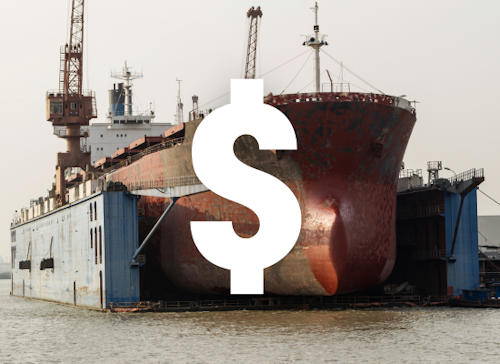Top 10 Ship Upgrades for a More Profitable Fleet

In the fast-evolving maritime industry, ship owners are increasingly focusing on strategic upgrades to boost efficiency and profitability. This article explores the top ten cash-positive updates for modernizing fleets, enhancing environmental compliance, and improving the bottom line. From advanced propulsion systems to cutting-edge navigation tools, each upgrade offers substantial returns and sets the stage for a sustainable and profitable maritime future.
* Please send feedback/suggestions to editor @ shipuniverse.com
1. Retrofitting with Energy Efficient Propulsion Systems
Overview
Upgrading to energy-efficient propulsion systems can significantly reduce fuel consumption, which is one of the largest operational costs in shipping. Advanced systems like hybrid or fully electric propulsion offer substantial savings over traditional diesel engines.
Example Scenario and Calculation
Consider a ship that spends approximately $10 million on fuel annually. By retrofitting the ship with a hybrid propulsion system, initial estimates show a potential fuel saving of up to 15-20%. The cost of retrofitting might be around $5 million, but the annual savings of $1.5 to $2 million imply a payback period of 2.5 to 3.33 years.
Calculation:
- Annual Fuel Cost: $10,000,000
- Expected Savings: 15-20%
- Annual Savings: $1,500,000 to $2,000,000
- Retrofit Cost: $5,000,000
- Payback Period = Retrofit Cost / Annual Savings
- Payback Period = $5,000,000 / $1,750,000 (average savings) ≈ 2.86 years
After the payback period, these savings contribute directly to the profitability of the vessel.
2. Installation of Scrubber Systems
Overview
Scrubber systems allow ships to use cheaper, high-sulfur fuel while complying with the IMO 2020 sulfur cap regulations. The cost difference between low-sulfur and high-sulfur fuel can offer significant savings, making the installation of scrubbers a financially attractive option.
Example Scenario and Calculation
If the price difference between low-sulfur fuel and high-sulfur fuel is $250 per ton and a ship consumes 20,000 tons of fuel per year, the annual savings from using cheaper fuel would be substantial. Installing a scrubber system might cost around $3 million.
Calculation:
- Fuel Consumption: 20,000 tons/year
- Price Difference: $250/ton
- Annual Fuel Savings: 20,000 tons x $250/ton = $5,000,000
- Installation Cost of Scrubber: $3,000,000
- Payback Period = Installation Cost / Annual Savings
- Payback Period = $3,000,000 / $5,000,000 = 0.6 years (approximately 7 months)
The quick payback period demonstrates the cost-effectiveness of this update, which not only saves money but also ensures regulatory compliance.
3. Advanced Hull Coatings
Overview
Applying advanced hull coatings can significantly reduce the resistance a ship faces while moving through water, thereby decreasing fuel consumption and increasing speed. This technology not only prolongs the intervals between dry-docking but also enhances fuel efficiency due to reduced drag.
Example Scenario and Calculation
Suppose a typical container ship spends approximately $9 million on fuel annually. Advanced hull coatings can improve fuel efficiency by up to 5%. The cost of applying these coatings might be around $500,000, but the annual savings in fuel costs can be substantial.
Calculation:
- Annual Fuel Cost: $9,000,000
- Expected Savings: 5%
- Annual Savings: $9,000,000 x 5% = $450,000
- Coating Cost: $500,000
- Payback Period = Coating Cost / Annual Savings
- Payback Period = $500,000 / $450,000 ≈ 1.11 years
After the payback period, the reduction in fuel costs contributes directly to the net profitability, making it a smart investment for improving operational efficiency.
4. Ballast Water Treatment Systems
Overview
Installing modern ballast water treatment systems is not only a regulatory requirement to prevent the transfer of invasive marine species but can also improve operational efficiency by reducing the time and resources spent on managing ballast water traditionally.
Example Scenario and Calculation
The installation of a ballast water treatment system can cost approximately $1 million for a medium-sized tanker. Though this installation does not directly save fuel like other technologies, it avoids potential fines and port delays, which can be quantitatively significant.
Calculation:
- Installation Cost: $1,000,000
- Avoided Fines and Port Delays: Estimated at $300,000 annually (This includes fines for non-compliance and additional port charges.)
- Payback Period = Installation Cost / Annual Cost Avoidance
- Payback Period = $1,000,000 / $300,000 ≈ 3.33 years
This upgrade is financially justifiable not just in terms of compliance but also in avoiding operational hassles and potential fines, contributing to smoother and more cost-effective shipping operations.
5. Energy-Efficient Lighting Systems
Overview
Switching to LED lighting or other energy-efficient lighting systems on board can drastically reduce the energy consumption dedicated to lighting, which, although a smaller portion of total energy use, adds up over the lifespan of a ship. This switch not only saves energy but also decreases the heat load inside the ship, potentially reducing the need for air conditioning.
Example Scenario and Calculation
Assume a ship spends about $20,000 annually on lighting using traditional systems. By transitioning to LED lighting, the energy consumption for lighting can be reduced by up to 60%. The cost for upgrading the lighting system might be around $100,000.
Calculation:
- Annual Lighting Cost: $20,000
- Expected Savings: 60%
- Annual Savings: $20,000 x 60% = $12,000
- Upgrade Cost: $100,000
- Payback Period = Upgrade Cost / Annual Savings
- Payback Period = $100,000 / $12,000 ≈ 8.33 years
While the payback period is longer compared to other investments, the benefits of reduced maintenance costs and longer lifespan of LEDs contribute further to the overall savings.
6. Automated Energy Management Systems
Overview
Implementing an automated energy management system (EMS) can optimize the ship’s power use, reducing fuel consumption by ensuring that energy production matches demand as closely as possible. These systems can intelligently manage power distribution and engine operation based on current needs, leading to significant efficiency improvements.
Example Scenario and Calculation
Consider a ship with annual fuel costs amounting to $10 million. An advanced EMS can improve overall energy efficiency by approximately 4%. The system installation might cost about $400,000.
Calculation:
- Annual Fuel Cost: $10,000,000
- Expected Efficiency Gain: 4%
- Annual Savings: $10,000,000 x 4% = $400,000
- System Installation Cost: $400,000
- Payback Period = System Installation Cost / Annual Savings
- Payback Period = $400,000 / $400,000 = 1 year
The rapid payback period makes this a particularly attractive investment, especially considering potential additional savings from reduced wear and tear on machinery and decreased downtime.
7. Solar Panel Installation for Auxiliary Power
Overview
Integrating solar panels to power auxiliary systems on board can significantly reduce the reliance on the ship’s main fuel system for generating electricity. This not only saves fuel but also decreases greenhouse gas emissions, aligning with global sustainability goals.
Example Scenario and Calculation
Assuming a ship spends around $500,000 annually on generating auxiliary power through traditional fuel-based systems. By installing solar panels, it’s feasible to offset approximately 10% of this energy use. The installation cost for a suitable solar panel system might be about $200,000.
Calculation:
- Annual Auxiliary Power Cost: $500,000
- Expected Energy Offset: 10%
- Annual Savings: $500,000 x 10% = $50,000
- Installation Cost: $200,000
- Payback Period = Installation Cost / Annual Savings
- Payback Period = $200,000 / $50,000 = 4 years
The investment in solar panels not only contributes to fuel savings but also enhances the ship’s green credentials, which can be beneficial for compliance and marketing purposes.
8. Advanced Onboard Waste Heat Recovery Systems
Overview
Waste heat recovery systems capture and reuse the heat that is a byproduct of the ship’s engine and other systems. This recovered energy can be used to power additional systems on the ship, improving overall thermal efficiency and reducing fuel consumption.
Example Scenario and Calculation
Consider a ship with an engine that typically consumes fuel costing $8 million annually. A well-designed waste heat recovery system can improve energy efficiency by about 5%. The cost of installing such a system is estimated at $600,000.
Calculation:
- Annual Fuel Cost: $8,000,000
- Expected Efficiency Improvement: 5%
- Annual Savings: $8,000,000 x 5% = $400,000
- Installation Cost: $600,000
- Payback Period = Installation Cost / Annual Savings
- Payback Period = $600,000 / $400,000 = 1.5 years
This technology not only reduces operational costs but also lessens environmental impact, offering a dual advantage of economic and ecological benefits.
9. Advanced Navigation and Route Optimization Systems
Overview
Implementing advanced navigation and route optimization systems can significantly reduce fuel consumption and voyage times. These systems use real-time data and predictive analytics to determine the most efficient routes, taking into account weather conditions, sea currents, and other navigational hazards.
Example Scenario and Calculation
Assume a ship operates with annual fuel costs amounting to $6 million. By using an advanced navigation system, fuel usage can be optimized to achieve up to a 4% reduction in fuel consumption. The system’s installation might cost about $250,000.
Calculation:
- Annual Fuel Cost: $6,000,000
- Expected Savings: 4%
- Annual Savings: $6,000,000 x 4% = $240,000
- Installation Cost: $250,000
- Payback Period = Installation Cost / Annual Savings
- Payback Period = $250,000 / $240,000 ≈ 1.04 years
This update not only saves fuel but also minimizes the risk of delays and reduces overall operational costs, making it a prudent choice for enhancing profitability.
10. Efficient Onboard Energy Management and Automation Systems
Overview
Upgrading to more efficient onboard energy management and automation systems can help in finely tuning the energy usage on various ship operations, leading to significant reductions in energy waste. These systems manage everything from HVAC to propulsion and lighting, optimizing the ship’s energy consumption across all functions.
Example Scenario and Calculation
Let’s consider a vessel with total annual energy costs of $7 million. A comprehensive upgrade to energy management and automation systems could lead to a 3% reduction in overall energy consumption. The installation of such systems might be estimated at $300,000.
Calculation:
- Total Annual Energy Costs: $7,000,000
- Expected Savings: 3%
- Annual Savings: $7,000,000 x 3% = $210,000
- Installation Cost: $300,000
- Payback Period = Installation Cost / Annual Savings
- Payback Period = $300,000 / $210,000 ≈ 1.43 years
These systems enhance operational efficiency and provide a quick return on investment due to savings from optimized energy usage, positioning them as essential for any modern ship aiming to maximize profitability and sustainability.
Investing in technological upgrades is crucial for adapting to the evolving demands of maritime transport. The ten updates highlighted not only promise immediate financial benefits but also long-term operational improvements. For ship owners, these investments are key to ensuring their fleets remain competitive and environmentally responsible, paving the way for a new era in global maritime operations.

Do you have any feedback or additional insights? Please reach out to editor @ shipuniverse.com
